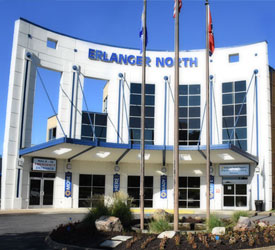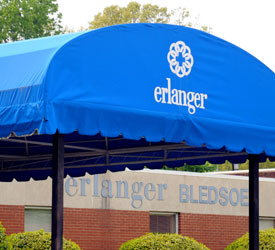Screening vs. Diagnostic Mammograms
A routine mammogram is the most effective screening test to detect breast cancer in individuals without any symptoms.
A diagnostic mammogram helps us take a closer look if a lump or issue is found in the breast.
Imaging Locations

A screening mammogram is an X-ray examination of the breast designed to identify the presence of breast cancer in individuals who do not exhibit any warning signs or symptoms, even when the cancer is too small to be detected by touch. Screening mammograms represent the most effective method for detecting breast cancer in most women and are the only tests demonstrated to reduce mortality rates associated with breast cancer.
Talk to your doctor about when and how often to get a screening mammogram. Erlanger offers specific guidelines based on your age, risk factors, and other considerations.
Erlanger Recommendations for Screening
First, stay calm. Most lumps aren’t cancer. In younger women, lumps frequently come with menstrual cycles and typically resolve on their own. Even so, it’s vital to consult a physician if you observe any of these changes:
- A lump, hard knot, or thickening in the breast or underarm area
- Swelling, warmth, redness, or darkening of the breast
- Alterations in the size or shape of the breast
- Dimpling or puckering of the skin; an itchy, scaly sore, or rash on the nipple
- Retraction of the nipple or other breast areas
- Sudden nipple discharge
If a lump or change is discovered, you provider will run follow-up tests
- A diagnostic mammogram takes additional images to closely examine the area of concern.
- A breast ultrasound uses sound waves to create images to help differentiate between a fluid-filled cyst and a solid mass.
- A breast MRI may also be recommended.
If follow-up tests indicate the possibility of cancer, a biopsy may be performed
This procedure involves removing cells or tissue for examination to determine the presence of cancer. A biopsy does not itself diagnose cancer, but it can help eliminate it as a possibility. Learn more about biopsies
As women age, they may develop small deposits of calcium, known as calcifications, in their breasts. These deposits are typically too minute to be detected through touch but can appear as small, bright white spots on a mammogram.
In most cases, calcifications are benign; however, specific patterns, such as tight clusters or linear formations, may raise concerns and warrant further investigation, as they could indicate the presence of breast cancer.
Calcifications are particularly prevalent among women over the age of 50 and may be associated with factors such as advancing age, previous injuries, or breast infections like mastitis. Additionally, for women who have undergone treatment for breast cancer, these calcifications may be linked to prior surgeries or radiation therapy.
This can also so be connected to the quantity of calcium in a woman’s diet.
Pamela's Story
"Just a few months makes a difference."
Pamela Stephens tells why it’s important to never miss a mammogram. She also explains how Erlanger’s comprehensive services and support resources helped her understand every step of the treatment process. It made her breast cancer treatment successful and her emotional journey easier.
423-778-PINK (7465)




